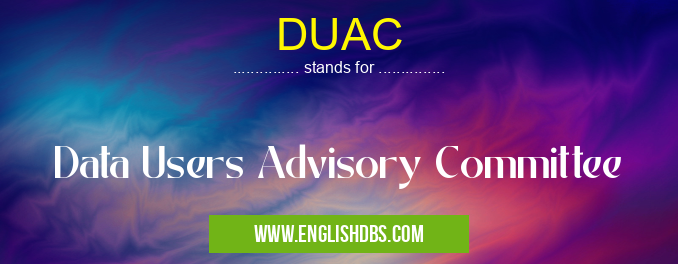What does DUAC mean in COMMITTEES
A Data Users Advisory Committee (DUAC) is an advisory group composed of stakeholders from different organizations such as businesses, government agencies, research universities, and other entities. Its purpose is to provide guidance on data requirements, innovative uses of data, and potential applications for the data collected by an organization.

DUAC meaning in Committees in Community
DUAC mostly used in an acronym Committees in Category Community that means Data Users Advisory Committee
Shorthand: DUAC,
Full Form: Data Users Advisory Committee
For more information of "Data Users Advisory Committee", see the section below.
» Community » Committees
Essential Questions and Answers on Data Users Advisory Committee in "COMMUNITY»COMMITTEES"
What is a Data Users Advisory Committee (DUAC)?
How does the DUAC help an organization?
The DUAC's advice helps organizations make decisions about data collection, utilization, and storage that are tailored to their specific needs while providing maximum benefit to users of their services. This enables an organization to maximize value from its data resources while minimizing costs associated with collecting or using those resources.
What elements do members need to consider when discussing data requirements?
When discussing data requirements, members should consider factors such as privacy concerns, accuracy of data collection, analyses needed for decision making purposes, cost savings opportunities associated with the use of available technology or existing datasets, and any other elements related to the particular context in which an organization collects and utilises data.
What kind of expertise is necessary for membership on a DUAC?
SUACs typically have representative members representing multiple stakeholders within an organization as well as external experts who may offer insight into emerging technologies or creative uses for current datasets. Additionally, members may possess subject-matter expertise in fields such as compliance, analytics software development or statistical analysis.
Who has primary responsibility for creating a DUAC?
The governing body overseeing the organization typically has primary responsibility for creating a DUAC. This body may also be responsible for setting out guidelines regarding how often meetings should take place and what level of input each stakeholder can provide during discussions.
What role does a DUAC usually fulfil?
A Data Users Advisory Committee (DUAC) typically fulfils two roles; advisory and decision-making. As advisors they provide inputs regarding potential applications of accessible information that could benefit the organization’s operations while offering potential solutions to any identified problems; whilst making decisions concerning how best to utilize existing information resources or implement new initiatives based on those recommendations.
How can a DUAC increase innovation in data use?
Networking across different sectors can facilitate creativity in terms of ways that collective datasets may be used collaboratively among multiple stakeholders or sectors. Increased networking also increases opportunities for gaining insights from sector-specific experts contributing valuable perspectives that would not have been previously considered due to different sectorial priorities or circumstances that presently exist.
Where does most communication occur within a DUAC?
Most communication occurs online via messaging platforms such as Slack or Teams allowing flexible collaboration between all stakeholders regardless of time zone differences however face-to-face meetings remain important especially when considering particularly sensitive topics requiring mutual understanding between stakeholders.
Are there guidelines surrounding membership appointment ontoaDUAC?
Yes - Guidelines concerning member appointment commonly include criteria outlining expected levels of experience with relation to either sectorial knowledge related directly towards proper decision implementation regarding existing datasets held within an organisations database or technical expertise required when considering software recommendations etc.,
